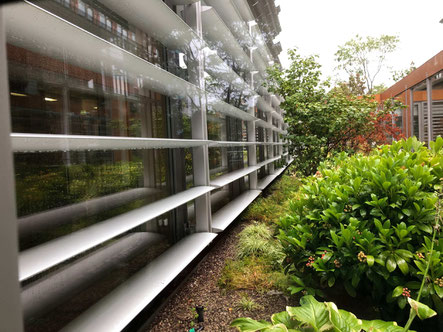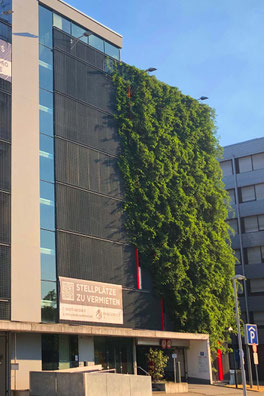
I recently heard a presentation by a climate manager of a medium-sized city on their advisory services to help companies adapt to the impacts of climate change. I thought it was a great offer, especially since the topic of adapting businesses has not really been established with cities nor with businesses. Encouraging: one company had already used the service and asked for specific advice. The company's problem was a high heat load in their offices caused by an extensive glass façade. The city's climate management recommended that the area in front of the building should be freed from asphalt and planted with greenery.
A good measure?
I myself am much in favor of so-called nature-based solutions for climate adaptation, as they can be effective, look great and offer many other benefits for nature and ourselves. But should that really be the measure of choice here? Does the cooling of the surface temperature in front of the building by vegetation really bring enough cooling inside the building? During the day, direct sunlight through windows will still heat up the rooms like in a greenhouse. The company has invested in the measure, but will it help to solve their problem sufficiently?

So what went wrong with the advice?
Any of the well-known measures against heat was simply singled out and recommended, without analysing whether it would help effectively in this case. All too often, I am asked myself: Please, provide me a list of the best measures! But there are no universally best measures. The greening of areas helps to keep outdoor areas cool and makes it more comfortable for us when being outside. In this case, the measure would be very effective, but for reducing the heat in the offices as requested by the company, the measure alone does not seem to be very suitable. Instead, the selection of measures should rather have looked into shading measures to reduce solar radiation getting into the building. Especially external shading elements that provide strong shadows appear effective. Nature-based solutions can also help, but it is trees, rather than greenery, that can shade the façade. However, they need time to develop sufficiently height. Or how about a trellis covered with climbing plants at some distance from the façade, which shades the glass surface and, at the same time, lets in enough light? The view of greenery is also attractive and, as studies have shown, has a positive effect on the mental well-being of employees.
... And what is needed instead?
There needs to be a systematic analysis of the climate risks which would show exactly what types of measures are needed and where. This would help to avoid ineffective measures, save their considerable costs, and instead, use the money to take measures that effectively reduce the risks. Unfortunately, this rarely happens with companies so far.
Do you want to save the costs of ineffective measures and get it right from the start?
>> Then take a look at my
